Golden hour - Study guides, Class notes & Summaries
Looking for the best study guides, study notes and summaries about Golden hour? On this page you'll find 1065 study documents about Golden hour.
Page 4 out of 1.065 results
Sort by
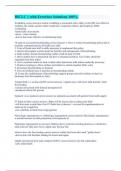
-
IBCLC || with Errorless Solutions 100%.
- Exam (elaborations) • 77 pages • 2024
-
Available in package deal
-
- $17.49
- + learn more
Swaddling correct answers routine swaddling is associated with a delay in first BF, less effective suckling, dec intake, greater infant weight loss, respiratory illness, hip dysplasia, SIDS, overheating -limits babys movements -stress = more calories -skin to skin more effective at maintaining temp 10 steps to successful breastfeeding correct answers 1. Have a written breastfeeding policy that is routinely communicated to all health care staff. 2. Train all heath care staff in skills nece...
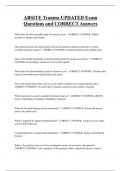
-
ABSITE Trauma UPDATED Exam Questions and CORRECT Answers
- Exam (elaborations) • 31 pages • 2024
-
- $9.49
- + learn more
ABSITE Trauma UPDATED Exam Questions and CORRECT Answers When does the first mortality peak for trauma occur? - CORRECT ANSWER- Within seconds to minutes after injury The trauma system and acute patient care has the greatest impact on patients in which mortality peak for trauma? - CORRECT ANSWER- Second mortality peak (golden hour) Most of the deaths during the second mortality peak for trauma occur from? - CORRECT ANSWER- Hemorrhage, central nervous system injuries When does the thi...
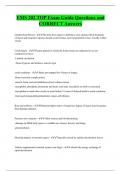
-
EMS 202 TOP Exam Guide Questions and CORRECT Answers
- Exam (elaborations) • 23 pages • 2024
-
- $9.49
- + learn more
Golden Hour/Period - The time from injury to definitive care, during which treatment of shock and traumatic injuries should occur because survival potential is best. Usually within 1 hour Crush Injury - Trauma pattern in which the body tissues are subjected to severe compressive forces. -Limited circulation -Tissue hypoxia and acidosis, muscle rigor crush syndrome - -Body part trapped for 4 hours or longer. -Broad systemic complications -muscle tissue necrosis(rhabdomyolysis) relea...
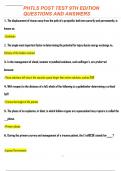
-
PHTLS Post test 9th edition Exam 2023 Questions with Answers
- Exam (elaborations) • 15 pages • 2023
- Available in package deal
-
- $9.99
- + learn more
PHTLS Post test 9th edition Exam 2023 Questions with Answers 1. The displacement of tissue away from the path of a projectile, both tem- porarily and permanently, is known as: A. Conization B. Cavitation C. Crepitation D. Contusion: B. Cavitation 2. The single most important factor in determining the potential for injury due to energy exchange is: A. Mass of the bodies involved B. Velocity of the bodies involved C. Density of the tissues involved D. Surface area of the impact involved: B. Veloci...
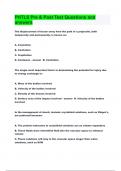
-
PHTLS Pre & Post Test Questions and answers
- Exam (elaborations) • 25 pages • 2024
- Available in package deal
-
- $14.49
- + learn more
The displacement of tissue away from the path of a projectile, both temporarily and permanently, is known as: A. Conization B. Cavitation C. Crepitation D. Contusion B. Cavitation The single most important factor in determining the potential for injury due to energy exchange is: A. Mass of the bodies involved B. Velocity of the bodies involved C. Density of the tissues involved D. Surface area of the impact involved B. Velocity of the bodies involved In the management...
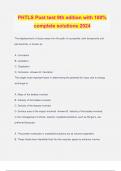
-
PHTLS Post test 9th edition with 100% complete solutions 2024
- Exam (elaborations) • 25 pages • 2024
-
- $13.49
- + learn more
PHTLS Post test 9th edition with 100% complete solutions 2024 The displacement of tissue away from the path of a projectile, both temporarily and permanently, is known as: A. Conization B. Cavitation C. Crepitation D. Contusion -Answer-B. Cavitation The single most important factor in determining the potential for injury due to energy exchange is: A. Mass of the bodies involved B. Velocity of the bodies involved C. Density of the tissues involved D. Surface area of the impact involv...

-
ATLS TEST 1 LATEST EXAM /ADVANCED TRAUMA LIFE SUPPORT TEST 1 LATEST QUESTIONS AND ANSWERS 2023/2024
- Exam (elaborations) • 22 pages • 2023
-
Available in package deal
-
- $11.00
- + learn more
What is the Golden hour --ANSWER- refers to the first hour after an injury until definitive care at the Trauma Center 50% of mortality immediately after injury, within the first hour. Most trauma deaths occur immediately at scene and within the GOLDEN HOUR How much time, in reality, do you have of the golden hour once a pt hits the ED door --ANSWER- about 30 minutes, called platinum half hour When someone has trauma, but they die later from it (within days to weeks) what is it typically d...
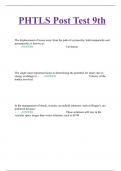
-
PHTLS Post Test 9th
- Exam (elaborations) • 20 pages • 2023
- Available in package deal
-
- $10.49
- + learn more
PHTLS Post Test 9th The displacement of tissue away from the path of a projectile, both temporarily and permanently, is known as: - ANSWER Cavitation The single most important factor in determining the potential for injury due to energy exchange is: - ANSWER Velocity of the bodies involved In the management of shock, isotonic crystalloid solutions, such as...
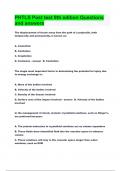
-
PHTLS Post test 9th edition Questions and answers
- Exam (elaborations) • 25 pages • 2024
-
- $14.49
- + learn more
The displacement of tissue away from the path of a projectile, both temporarily and permanently, is known as: A. Conization B. Cavitation C. Crepitation D. Contusion B. Cavitation The single most important factor in determining the potential for injury due to energy exchange is: A. Mass of the bodies involved B. Velocity of the bodies involved C. Density of the tissues involved D. Surface area of the impact involved B. Velocity of the bodies involved In the management...
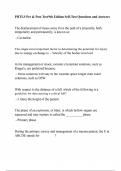
-
PHTLS Pre & Post Test 9th Edition Self-Test Questions and Answers
- Exam (elaborations) • 55 pages • 2024
-
- $12.00
- + learn more
The displacement of tissue away from the path of a projectile, both temporarily and permanently, is known as: - Cavitation The single most important factor in determining the potential for injury due to energy exchange is: - Velocity of the bodies involved In the management of shock, isotonic crystalloid solutions, such as Ringer's, are preferred because: - These solutions will stay in the vascular space longer than water solutions, such as D5W With respect to the distance of a fall, w...

Did you know that on average a seller on Stuvia earns $82 per month selling study resources? Hmm, hint, hint. Discover all about earning on Stuvia


